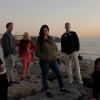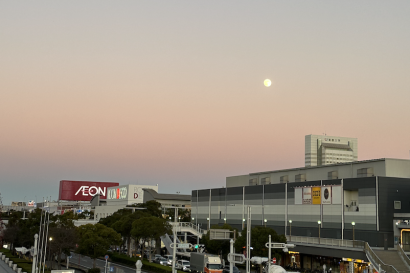In the second week of our program, IES Abroad took us to Potsdam, a city next to Berlin and the home of Sanssouci, the palace of the king of Prussia. While touring Sanssouci, we came upon a green room where our guide paused to tell us the historical significance of the couches and the fireplace, completely ignoring the red paint on the wall. It looked like someone had haphazardly scrawled with a paint brush, a lazy tag, right on the silk covered wall of the palace. It was clear that no one was trying to hide it, but no one really wanted to showcase it either—about half of it was covered by a painting. I couldn’t tell exactly what it was, but it seemed to be a crude hammer and sickle under something written in Russian.
Our guide made no mention of it and was about to leave the room, when someone asked what it said. “Oh, that? It’s just from the Soviet soldiers,” he said briskly and then left the room without further explanation, clearly finding this detail uninteresting, not worth mentioning, and unimportant compared to the lives of the royals who summered in Potsdam in the eighteenth century.
Last week while in Saints Petersburg, we had a week of tours like this. Before leaving for Russia, all of our classes discussed various aspects of Russian identity, culture and politics. This included an interesting discussion in my sociology class about the national narrative promoted by Russian politicians—a narrative which highlights the importance of the Czars and the “Great Patriotic War” (what Russians call World War II) while glossing over Stalinism and other unfavorable aspects of communism. We were certainly able to see this at work in our tours of the Hermitage, the Church of the Savior on Blood and St. Isaac’s Cathedral.
For example, during our tour of the Church of the Savior on Blood (perhaps Saint Petersburg’s most iconic church), our guide highlighted the imperial history of the Church, which is built on the site where Alexander II was killed. Near the end of the tour, she briefly mentioned that after the Great Patriotic War, the Church was used to store potatoes.
Similar passing references were made to the Soviet histories of the buildings of our other tours. In the Hermitage, we were briefly told in passing that the Small Dining-room we were standing in was where on October 25, 1917 the Bolsheviks arrested the Provisional Government. You know, no big deal.
In the Moika Palace, we talked about the Soviets a little more, mostly in reference to the decedents of the family who owned the palace before the revolution. Apparently some of them come to visit occasionally, and their pictures were displayed in one of the rooms of the palace. A few people on the tour were a little confused and upset as to why this family was not given the palace back after the collapse of the USSR, but I couldn’t help but wonder if they would also argue for slave reparations while on a plantation tour.
It’s hard not to make comparisons between places. It’s hard not to talk about Saint Petersburg without talking about Berlin, Paris without talking about New Orleans, Budapest without talking about Baltimore, whether there is a direct historical connection or the similarities seem only coincidental. When I started this trip, I really resented that I was so inclined to compare, perhaps rightfully so.
But in the moment, walking through beautiful gold palaces of Saint Petersburg and learning about the Imperial Czars, I couldn’t help but think of our trip to Potsdam, where a tour guide ignored the red paint on the palace walls.

Ruth Marie Landry
<p>Ruth Marie Landry is a junior majoring in the Writing Seminars at the Johns Hopkins University in Baltimore, MD. On campus, she works in the library and as a tutor for high school students. She is also a DJ for WJHU (Johns Hopkins' only student radio station) and the co-founder and co-editor-in-chief of Vector Magazine, an online literary magazine. While growing up in New Orleans, she developed a love for spicy food, dancing to live music, and long, poorly planned road trips. Ruth enjoys big cities, Sphynx cats and Brutalist architecture.</p>










